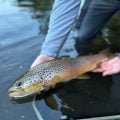How to Tie a Hare’s Ear Parachute
Producer: Tim Flagler
The Hare’s Ear Parachute is a great fly to have in your arsenal, as it, like its nymphal counterpart, represents a wide range of mayfly species, from Drakes to March Browns. Because it floats well, it also works nicely in a dry dropper rig.
The fly starts with a size 12 dry fly hook, here, a TMC 100. Get the hook firmly secured in the jaws of your tying vise.
For thread, I’ve loaded a bobbin with a spool of tan UTC 70 Denier. Get the thread started on the hook shank, leaving an eye-length-and-a-half space behind the back edge of the hook eye.
Deer hair is used for the tail of the fly. I prefer something that isn’t overly hollow, so it doesn’t flare a ton when tied in. I also want the hair to have nicely colored tips. Snip a small clump free from the hide and remove all the light, fluffy stuff from the butt ends, and get rid of any overly short or long hairs. Place the clump, tips first, into a stacker and give it a real good stacking. It’s best to keep the tail nice and sparse, maybe 20 hairs at the most. Remove the hair from the stacker, with its tips pointing to the rear of the fly. The tips all should be in rather close alignment.
Measure to form a tail a hook shank in length and transfer that measurement rearward to the start of the bend. Snip off the excess butt ends at the location of your tying thread, then give your bobbin a counterclockwise spin so the first wrap of tying thread will jump slightly rearward and catch those very butt ends. Continue taking wraps down the hook shank, pulling the deer hair up and toward you as you go. This will ensure it lands on top of the hook shank, as opposed to being pushed down the sides. Bind the hair down all the way to the start of the hook bend, it should flare a little bit, but not excessively. Relocate your tying thread forward, up the hook shank, to just shy of the initial tie-in point.
Small, oval, gold tinsel is used to rib and segment the fly, a 6” length is enough for numerous flies. Anchor the tinsel to the near side of the hook with tight wraps of tying thread, all the way back to the base of the tail. Once again relocate your tying thread to just rearward of the initial tie-in point.
White polypropylene floating yarn is used for the wing of the fly. A card-width segment is plenty. Place one end of the segment on top of the hook shank and take nice tight rearward thread wraps to bind it down. While maintaining your grip on the yarn, lift the end up and snip it off at a shallow angle. Pull the front portion of the yarn up to vertical and give it a real good clockwise twist, as if you’re looking down on it. Fold the yarn over, allowing it to furl on itself. Pinch the base of the newly formed post and anchor the loose end of the yarn to the hook shank, immediately in front of the post. Make sure that it’s bound down really well. Reach in with your tying scissors and carefully snip off the excess yarn at a shallow angle. Take care while doing this as it’s easy to accidentally snip the fibers of the wing post and your tying thread. With the trimming done, cover the butt ends of the yarn with wraps of tying thread. The wing post should now look something like this.
Start taking clockwise thread wraps up the post to stiffen its base. Go all the way up with the posting wraps to a point about 1/4” above the top of the hook shank. Then, take touching wraps down, all the way to the base of the post. Make sure to take a full thread wrap or two around just the hook shank to save your work. Now that you have the post firmly established, take thread wraps rearward to the midpoint of the hook shank.
Natural light hare’s mask dubbing is used to create both the abdomen and the thorax of the fly. For the abdomen, pluck an ample clump free from the packet, then pull down on your bobbin to expose about 4” of tying thread. Use the dubbing to create a slender, slightly tapered noodle on your thread. When you’re happy with the look of the noodle, start taking wraps with it so the dubbing begins right at the base of the tail. Continue taking touching wraps with the noodle up the hook shank to create the abdomen of the fly. Ideally you want the dubbing to end, leaving an eye-length space open behind the wing post.
Get hold of the gold tinsel and start making open spiral wraps with it over top of the dubbed body, 5 or 6 turns usually looks pretty good. When you reach your tying thread, use it to anchor the tinsel then snip the excess off close. If there are any truly wonky dubbing fibers sticking out, now’s the time to trim them off as well. Advance your tying thread forward to just behind the hook eye.
Grizzly hackle is used to form the parachute. I prefer to use a single feather from a grizzly saddle rather than a cape, as the overall feathers are generally longer and more densely barbed. Check to make sure you have a feather with barbules the correct length, here a perfect size 12, prior to plucking it free from the skin. This particular feather is better than 12” long and, although it might seem sacrilegious, I’ll snip off a 4” length to make things more manageable. With the shiny side of the feather facing you, pull down and strip off any webby or misshapen fibers from both sides of the stem. Then, strip a few extra fibers from just the top side of the stem. This will help the feather to wrap correctly.
Measure so you have enough bare stem to run from the back edge of the hook eye to the base of the post, then up the post. You really just have to eyeball it here. Snip any excess stem off then flip the feather around so the dull side faces you. Place the end of the stem at the back edge of the hook eye and give your bobbin a counterclockwise spin so, once again, the first wrap of thread will jump rearward and catch the very end of the stem. Continue taking thread wraps rearward to bind the stem to the near side of the hook, all the way back to the base of the post. Then, lift the feather up to vertical and start taking thread wraps around the post and the stem. Keep taking wraps up the post until you reach that point, about 1/4” up from the hook. You can then take touching thread wraps back down the post to its base. Here too, take a wrap around just the hook shank to save your work.
Go back to the same hare’s mask dubbing as before and, this time, take a much smaller pinch. Use the dubbing to create a thin noodle, about 1 1/2” in length on your tying thread. Start taking wraps with the noodle to cover all the bare thread wraps between the back edge of the hook eye and the abdomen of the fly. The idea is to build up an ample little thorax in the process. End with your tying thread in front of the post on the near side of the hook, like so. Using your fingers or hackle pliers, get hold of the hackle feather’s tip and start making clockwise wraps with it around the post. That extra bit of bare stem will help to ensure the feather wraps correctly. Continue taking touching wraps, one under the previous, all the way down the post to its base, doing your best to trap as few hackle fibers as possible. At the base of the post, take thread wraps around it to secure the tip of the hackle feather. Once you have it well anchored, reach in with your tying scissors, and carefully snip the excess tip off close.
Pick up your whip finish tool and use it to do a vertical whip finish right at the base of the post, so your thread just skims over top of the abdomen and the eye of the fly. After 4 or 5 turns, seat the knot really well and snip or cut your tying thread free. Invariably, they’ll be some trapped fibers on the far side of the fly. Simply reach in with the very tips of your tying scissors and snip them off close. Head cement, here, Sally Hansen Hard as Nails, applied to the thread wraps at the base of the post, will ensure nothing comes unraveled. And now for the fun part. Snip just the very tip of the wing post off square, and tease out the polypropylene yarn to form a good-looking vertical wing post.
I really like how this tying method leaves such a clean underside and how the somewhat dense hackle fiber parachute helps to keep the fly floating throughout many a drift.
How to Tie a Hare's Ear Midge
How to Tie a Hare's Ear Soft Hackle











